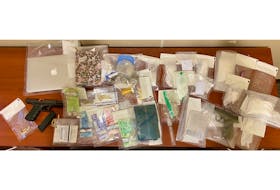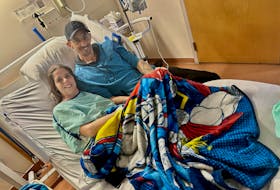
John Carter says everyone gets tremors, just that most people’s tremors are so fine they don’t notice.
But Carter isn’t like most people, he has what’s called essential tremor, a progressive neurological disorder most often associated with shaking of the arms or hands.
Carter said when people see tremors they might associate it with Parkinson’s disease, alcoholism or simply old age. But that isn’t the case with essential tremors; he inherited the disorder from his parents. It’s not a fatal disease and it doesn’t always have to do with age.
But Carter’s essential tremors have become worse with time. That’s why he’s seeking a revolutionary new treatment that uses focuses ultrasound to stop the tremors.
The treatment is only being done in one place in Canada – Sunnybrook Hospital in Toronto. Carter can get one arm done for free because the treatment is experimental.
Carter says he’s on a wait list and there are only three Nova Scotians being considered for treatment right now.
He’s wary of conventional treatments for essential tremors; one involves surgery, drilling holes into the head. He treated his disorder with medication when he was younger, but ran into problems.
“The meds work, but the side effects are difficult.”
Carter says essential tremors, which are classified as a movement disorder, change the way you live your life.
Carter explains that unlike most people with Parkinson’s, his tremors occur when he moves his hands. When he places his hands still on his lap, there is barely a quiver.
Carter explained that when he was younger he loved to draw, write and paint. He has difficulty doing those things now.
Carter has a piece of paper he typed up with information on essential tremors. His name is at the top, the letters are perfectly shaped in handwriting, but the lines are jagged because of his tremor.
The tremors make it difficult to do things others might take for granted, like eating. Carter has to be careful about what he chooses to eat, avoiding soups and chowders. He says some people might be self-conscious about their disorder.
“You have to depend on others and that can be humbling. But you have to go, you have to push yourself.”
Carter isn’t shy about asking for help in restaurants and coffee shops. He also receives help from his friend Gerard Veldhoven. When it comes to buttoning a new shirt, or tying a shoelace, Veldhoven is willing to help.
Carter said essential tremors can be difficult to deal with emotionally.
“You go through life enjoying and loving things and then as you age you’re not able to do all those things.”
But with the support of friends and loved ones, Carter knows the disorder can be managed.
Still, Carter is hopeful he’ll receive the new ultrasound treatment. He’s waiting for a telemedicine interview with the Sunnybrook hospital, where doctors will decide whether he’ll be treated.
If the experimental trials are successful, it could mean new treatment for people with essential tremors, as well as people who have brain tumours or Parkinson’s disease.
“Think of how powerful it would be,” he said.
Carter wants to get the word out to more people who may be suffering from essential tremors that there are alternatives to medication and surgery.
Essential Tremor Facts:
– Often referred to as “kinetic tremor”
– One of the most common neurological disorders
– Prevalence higher among people aged 40 and older
– 50 per cent of cases are passed down from family members
– Tremor intensity can worsen with caffeine, stress or fatigue
– ET does not occur during sleep
– ET mostly occurs during voluntary movements, such as eating and writing
– Many people with ET may be shy, embarrassed or anxious about their condition in public








